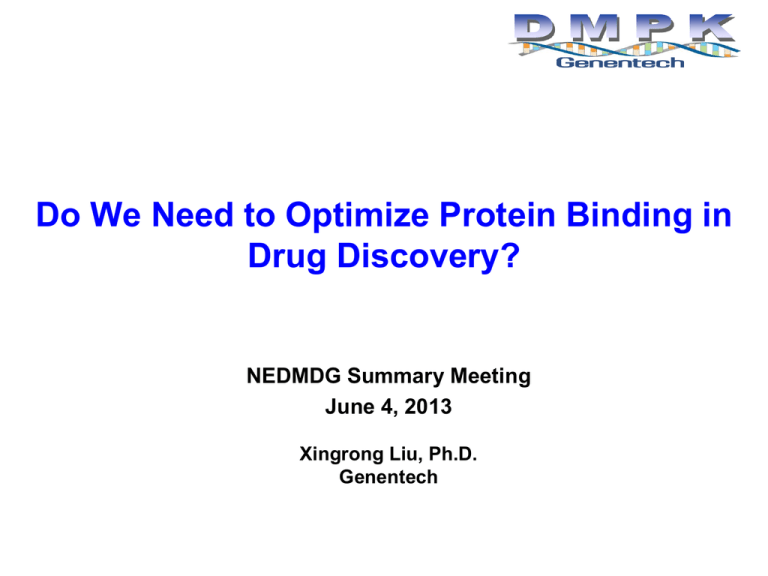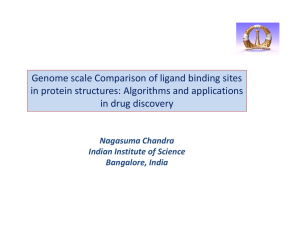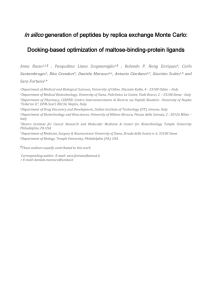Do we need to optimize plasma protein binding in drug discovery?
advertisement

Do We Need to Optimize Protein Binding in Drug Discovery? NEDMDG Summary Meeting June 4, 2013 Xingrong Liu, Ph.D. Genentech Free drug interacts with drug targets: Plasma Total IC50 = 0.3- 300x Ki Free IC50 = 0.1-10x Ki Liu et al., Drug Metab Dispos 37:1548–1556, 2009 100 100 80 80 SERT Occ (%) SERT Occ (%) Brain binding does not contribute to the activity: free drug interacts with drug targets 60 40 20 0 -20 0.01 60 40 20 0 0.1 1 10 100 1000 10000 -20 0.01 0.1 1 10 100 1000 10000 Total Brain Concentration/KI Unbound Brain Concentration/KI Total IC50 = 1-1000x Ki Free IC50 = 0.3-3x Ki Liu et al., Drug Metab Dispos 37:1548–1556, 2009 Different effects of protein binding on in vitro and in vivo free concentrations In vitro In vivo Scenario 1 fu=0.1 fu=0.5 fu ↑ fu=0.1 fu ↑ Clin↔ fu=0.5 Cu↔ Cbound fu=0.5 Cbound Cbound Cbound Cu ↑ Cu Cu Scenario 2 fu ↑ Clin↓ Cu ↑ Increase of free fraction by 15X increases IV free AUC by 3X R2 1 1 G-378895 IV 3 mg/kg R1 Cl Unbound Conc. (ug/mL) Total Conc. (ug/mL) 10 G-378242 IV 3 mg/kg fup=0.01 0.1 R2 0.01 fup=0.15 N G-378895 IV 3 mg/kg G-378242 IV 3 mg/kg 0.1 0.01 0.001 R1 0.001 0.0001 0 6 12 Time (h) 18 24 0 6 12 Time (h) • 3X increase was due to reduced clearance 18 24 Increase of free fraction by 15X increases oral free AUC 2X 1 G-378895 PO 10 mg/kg R2 Unbound Conc. (ug/mL) Total Conc. (ug/mL) 10 G-378242 PO 10 mg/kg R1 1 Cl fup=0.01 R2 0.1 N R1 fup=0.15 G-378242 PO 10 mg/kg 0.1 0.01 0.001 0.01 0 G-378895 PO 10 mg/kg 6 12 Time (h) 18 24 0 6 12 Time (h) • 2X increase was due to reduced clearance 18 24 Protein binding vs. intrinsic clearance H N O O C2H5 HN R O R = -(CH2)nCH3 n = 0-8 Data form Blakey et al., J Pharmacokinet Biopharm 25:277–312, 1997 Protein binding vs. Vdss H N O fu plasma Vd Vc Vt fu tissue O C2H5 HN R O R = -(CH2)nCH3 n = 0-8 Data form Blakey et al., J Pharmacokinet Biopharm 25:277–312, 1997 Protein binding vs. t1/2 H N O O C2H5 HN R O R = -(CH2)nCH3 n = 0-8 Data form Blakey et al., J Pharmacokinet Biopharm 25:277–312, 1997 Protein binding vs. intrinsic clearance 100000 Acids 10000 Clin (ml/min/kg) Clin (ml/min/kg) 100000 1000 100 10 Bases 10000 1000 100 10 1 1 0.1 0.0001 0.001 0.01 0.1 0.1 0.0001 1 0.001 fu 0.1 1 fu Neutrals 1000 10000 Clin (ml/min/kg) Clin (ml/min/kg) 100000 0.01 1000 100 10 Zwitterions 100 10 1 0.1 0.001 0.01 0.1 fu 1 1 0.01 0.1 1 fu Data form Obach et al., Drug Metab Dispos 36:1385–1405, 2008 Protein binding vs. Vdss fu plasma Vd Vc Vt fu tissue Data form Obach et al., Drug Metab Dispos 36:1385–1405, 2008 Protein binding not associate with t1/2 Acids 10000 100 t1/2 (hr) 1000 t1/2 (hr) Bases 1000 100 10 1 10 1 0.1 0.1 0.0001 0.001 0.01 0.1 0.01 0.0001 1 0.001 fu 1000 0.01 0.1 1 fu Neutrals 100 Zwitterions 100 t1/2 (hr) t1/2 (hr) 10 10 1 1 0.1 0.001 0.01 0.1 fu 1 0.1 0.01 0.1 1 fu Data form Obach et al., Drug Metab Dispos 36:1385–1405, 2008 Brain unbound conc. is governed by the BBB and plasma unbound conc. Cu ,brain 1 1 Cu , plasma Clefflux PS Clefflux: efflux transport activity at the BBB PS: diffusion permeability at the BBB Protein binding does not associate with brain penetration R2=0.077 R2=0.087 Modified from Maurer et al, Drug Metab Dispos 33: 165, 2005 Significant effects of P-gp on brain concentration Compound Efflux Compound 18 CsA Desloratadine 14 Verapamil 8 Efflux Digoxin 16-28 Ivermectin 14-27 Chen et al, Curr Drug Metab, 4: 272, 2003 Considerations of protein binding in drug discovery • No need to specifically optimize plasma binding – Reduction of plasma protein binding alone does not increase free drug concentration – Reduction of clearance increases free drug concentration – Reduction of plasma protein binding tends to associated with reduction of clearance, as both of the parameters are governed by lipophilicity • No need to specifically optimize brain binding • • Reduction of brain tissue binding alone does not increase free brain drug concentration Reduction of efflux activity enhance free brain drug concentration • Need to consider protein binding in … – PK/PD, human PK/dose/DDI prediction, drug transporter/tissue penetration, safety margin calculation, regulatory filing, etc. Acknowledgements • Marcel Hop • • Bruce Roth Joe Lyssikatos • • • R. Scott Obach Franco Lombardo Nigel J. Waters • Dennis A. Smith Protein binding of marketed drugs 30% n = 267 25% Drugs (%) 20% 15% 10% 5% 0% <0.001 0.001-0.01 0.01-0.05 0.05-0.1 0.1-0.3 0.3-0.6 0.6-1 Unbound Fraction n=14, fu<0.1 Data from Goodman & Gilman’s The Pharmacological Basis of Therapeutics, 11th 0.0001 Modified from Maurer et al, Drug Metab Dispos 33: 165, 2005 Meprobamate Sulpiride Hydrocodone Caffeine Morphine Metocloperamide Methylphenidate Lamotrigine Buspirone Venlafaxinec Carisoprodol Zolpidema Thiopentalc Carbamazepine 9-OH-Risperidone Phenytoin Risperidone Selegiline Diazepam Trazodone Propoxyphene Citalopram Midazolam Hydroxyzine Clozapine Fluvoxamine Cyclobenzaprine Haloperidol Nortriptylinea Paroxetine Fluoxetine Chlorpromazine Sertraline Brain fu Many successful CNS drugs show high brain binding 1 0.1 0.01 0.001 th io p ph ent en al yt s u oi n lp ir z o i de lp id m em or p tra hi n zo e ris do pe ne rid m la m on et e o c otr lo igi pe ne ra bu mid hy s pi e dr ron pr o co e op d ox on yp e pa he n ro e xe s e tine le g c l i li n oz e v e ap nl ine af a c i xin ta e fl u l op vo ram xa hy m dr i o x ne no y zi cy ne r t r cl ob ipty en li n za e p m fl u rine et h y oxe lp ti n he e ni d h c h al o ate p lo rp eri ro do m l a s e z ine rtr a m l i d ine c a azo c a ri so lam rb p r a m od az o l ep c a ine et ho ffein su e xi m di i az de ep am AUCbrain/AUCplasma (0-5h) 240x th io pe ph nta en l yt o su in lp i ri z o de lp id m em or ph tra i n zo e ris do pe ne rid m la m one et o c otr lo igi n pe ra e bu mid e s hy pir on dr pr o co e op do ox n yp e pa he n e ro xe s e tine le g c l i li ne oz v e api n nl af e a c i xin ta e fl u l op vo ram xa hy m i dr o x ne no y zi cy rtr ne cl ob ipty en li n za e pr m fl uo ine et h y xet in lp he e n ha id a t ch lo p e lo rp erid ro o l m az s e ine rtr a l m i d ine c a azo ri s la m ca o rb p ro am d az o l ep c a ine ffe di ine az ep am 34x AUCu,brain/AUCu,plasma (0-5h) Plasma and brain binding has a significant impact on the B/P ratio 25 20 Total Brain/Plasma Ratio 15 10 5 Acid: 0.5 (0.4-0.6) Base: 6 ± 7 (0.1-24) Neutral: 0.9 ± 0.7 (0.2-0.8) 0 25 20 Unbound Brain/Plasma Ratio 15 Acid: 0.2 (0.2-0.3) Base: 1 ± 0.7 (0.1-3.4) Neutral: 0.5 ± 0.3 (0.1-1) 10 5 0 Modified from Maurer et al, Drug Metab Dispos 33: 165, 20 Protein binding vs. clearance Data form Obach et al., Drug Metab Dispos 36:1385–1405, 2008 Protein binding vs. free Vdss Data form Obach et al., Drug Metab Dispos 36:1385–1405, 2008 Questions for protein binding • PPB non-linearity – saturation of PPB as a strategy to increase unbound concentration – is this a viable strategy? • Covalent modifiers – does PPB even matter? Is it always total plasma concentration? • What about "exceptions to the rule"? - e.g. Active transport? Nonwell stirred assumption? • Impact on Cmax and Cmin – this could be sensitive to fu – see Derendorf paper I circulated • Determination of unbound PK parameters (Clunbound – Vd,ssunbound) – does this simplify or complicate things? • Species differences? • What should we use PPB data for in drug discovery?

